For those humanitarians and environmentalists out there, engagement ring shopping can be a struggle. Due to the carbon footprint – among other things – caused by diamond mining, younger people are attempting to take a step away from the traditional engagement ring. This has led to a fast growing trend – lab-grown diamond rings.
According to BBC Future, almost 70% of millennials have considered this guilt-free engagement ring alternative. An added bonus to lab-grown diamonds for your engagement ring is that they are much more affordable, meaning you won’t break the bank.
So what exactly is a lab-grown diamond?
Essentially, they are man-made diamonds. What’s interesting, however, is that while they are created in laboratories, they are chemically and physically identical to natural diamonds, and are just as hard.
There are two main methods used to grow these diamonds: The CVD (chemical vapor deposition) method and The HPHT (high pressure high temperature) method. Lightbox, a company who lab-grows diamonds describes these methods:
CVD – “Lab grown diamond seeds are loaded into a CVD reactor. Then, a mix of gasses containing carbon is added at a very low pressure. Microwaves are added to heat the gases and generate a plasma. When the temperatures climb over several thousand degrees, the gas molecules break apart and carbon atoms bond to the seeds, growing them one layer at a time,” says Lightbox.
HPHT – “This method mimics the conditions under which diamonds naturally form. Large mechanical presses are used to apply extreme pressure and high temperature to carbon in the presence of a diamond seed. The seeds act as a template for a lattice of carbon to grow layer by layer over the course of a few days,” they said.
Because of their man-made nature, they only take a few weeks to make whereas a real diamond takes billions of years to grow.
So if you’re looking to live a more eco-friendly, sustainable and conscious life then lab-grown diamonds are the way to go!
Here are some lab-grown diamond engagement rings to inspire you:
https://www.instagram.com/p/Bvxi-HzlGKH/
https://www.instagram.com/p/BiwA1PGhFJO/
https://www.instagram.com/p/B6wwQL9hKt0/
https://www.instagram.com/p/B7x42eRF1K0/
https://www.instagram.com/p/B9F6woGBMzO/
Image: Unsplash

